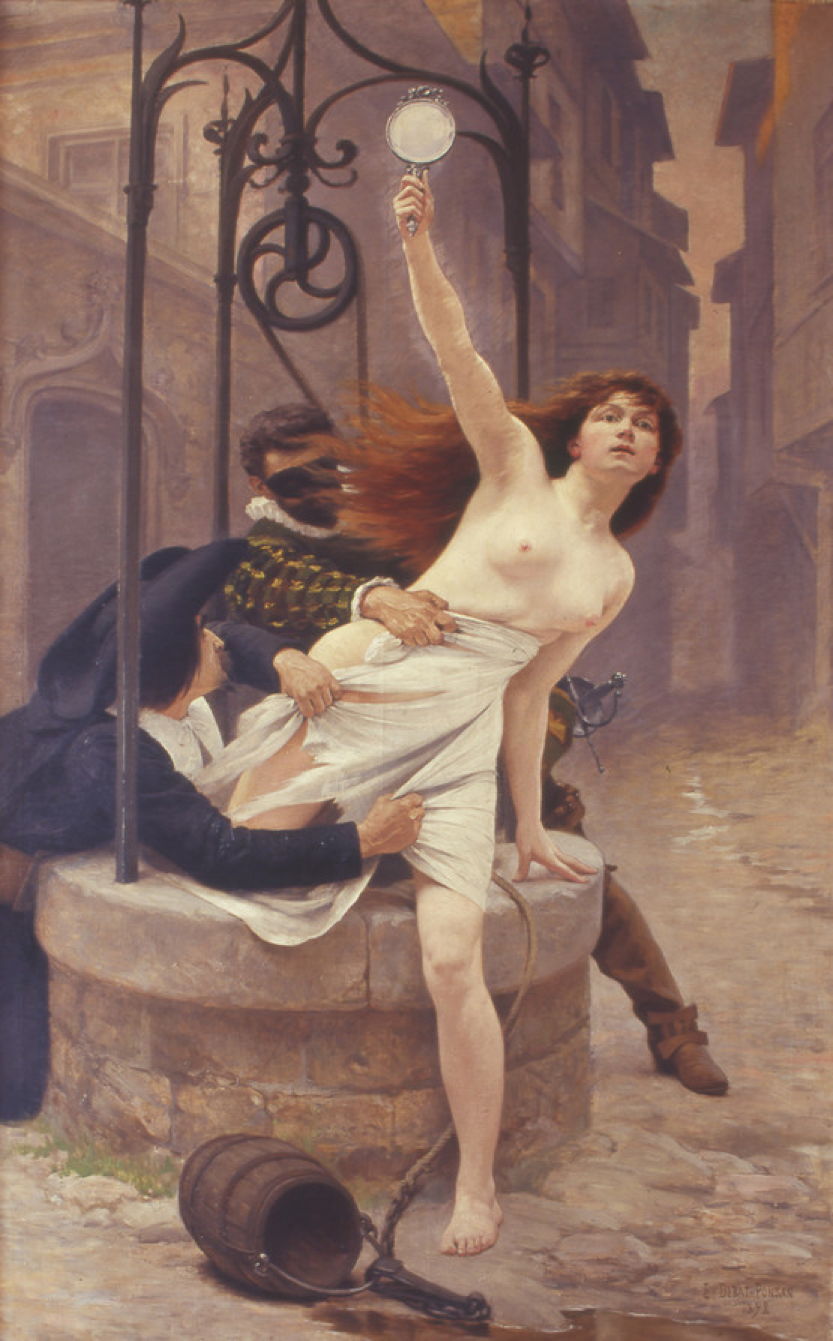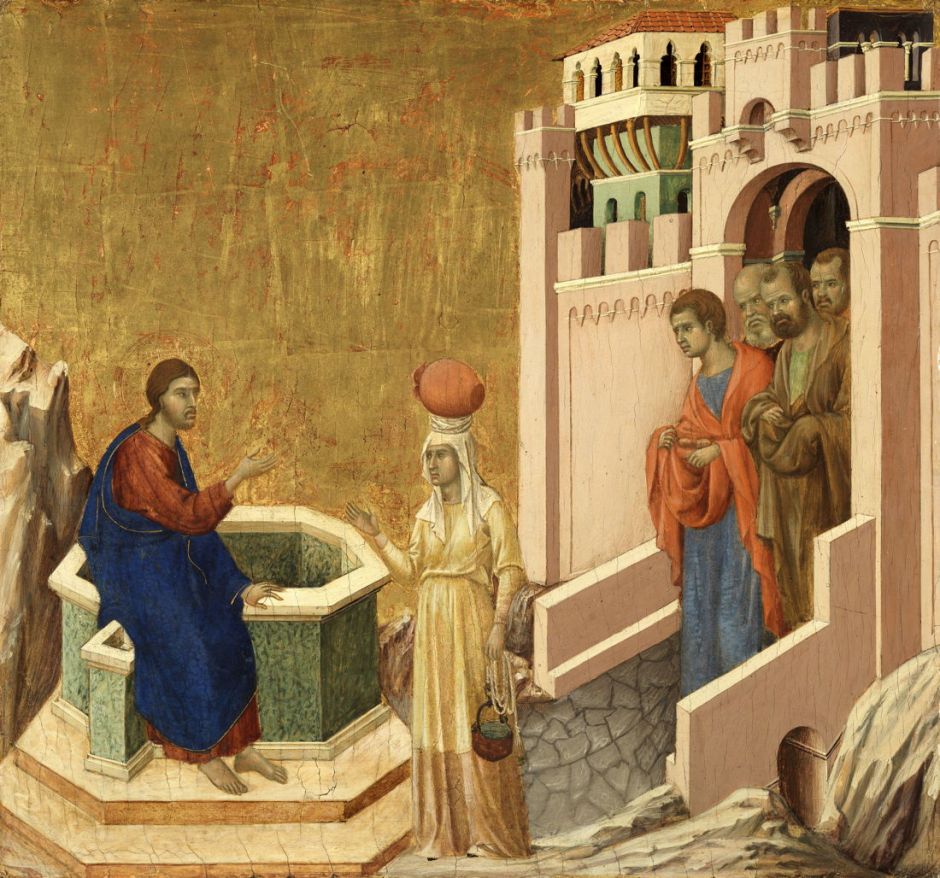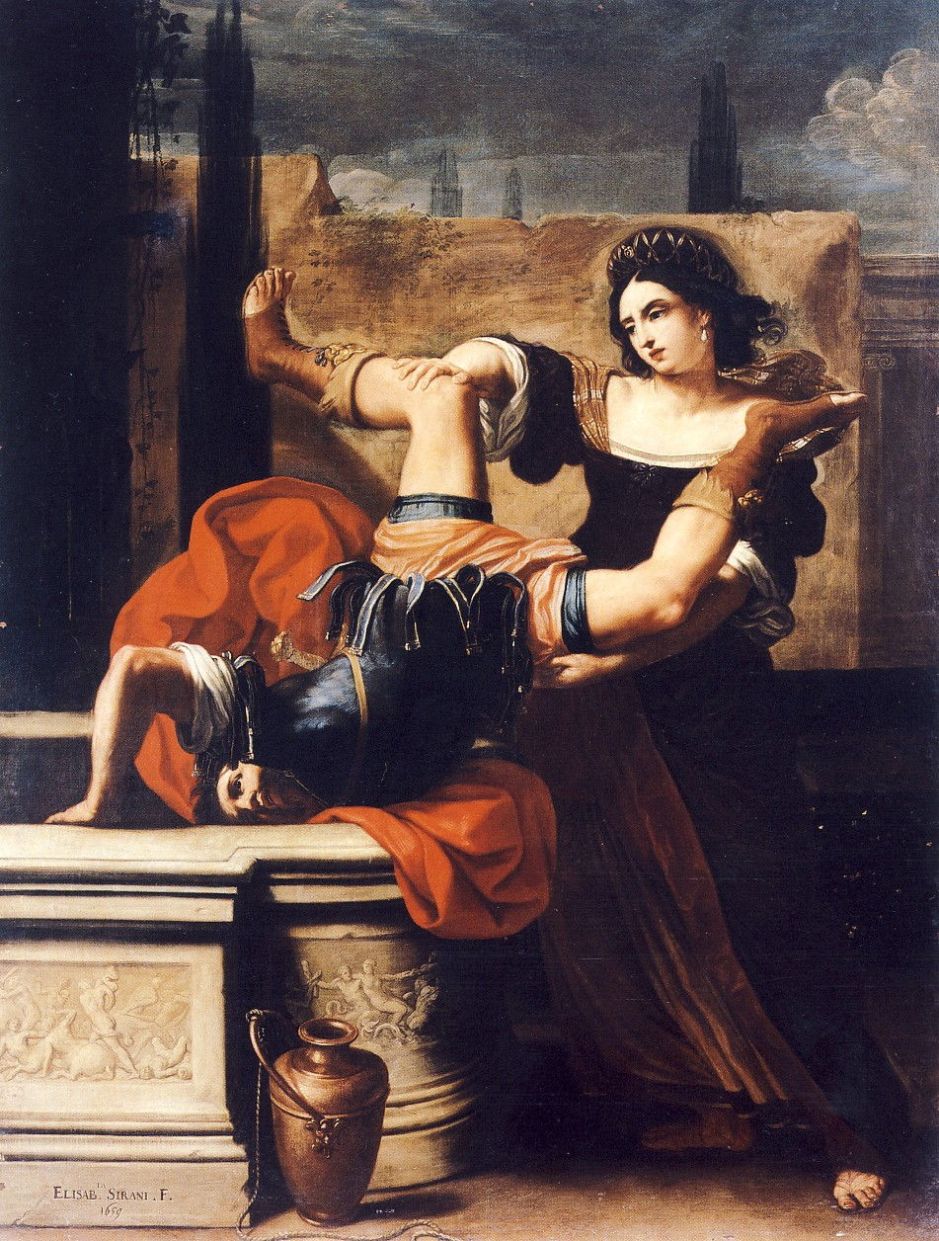For much of the world, until the arrival of piped water supplies from the nineteenth century onwards, fresh water was likely to come from a well, a hole dug into the ground that is deep enough for groundwater to gather at the bottom. Although pumps were developed long ago, for most wells, water was fetched from the bottom in a simple bucket on the end of a length of rope.
Wells were commonplace to the point of being everyday and dull, so have only infrequently featured in paintings. This article shows examples of their use and reading, from their special association with the personification of Truth, to their role in the disposal of bodies.
There have been various literary associations between Truth and wells, but it doesn’t appear that two became associated in visual art until the late sixteenth century.

Annibale Carracci’s Allegory of Truth and Time from 1584 is one of the earliest paintings to make this association. The winged Father Time, who lacks the scythe he’s most commonly associated with, is here putting his shoulder to Truth to raise her from the well. She’s clutching a mirror in her right hand.
Trampled under the feet of Truth is the strangely chimeral two-faced figure of Deceit. The two figures framing the image are more controversial: the official identification gives them as Good Luck or Happiness on the left, and Happy Ending on the right. That on the left bears a winged caduceus and a cornucopia (horn of plenty), which is an unusual combination that may allude to good health as well as abundant food. That on the right is scattering Spring flowers, which might relate her to Flora.
There doesn’t appear to be any visual precedent to Carracci’s image, which must therefore be the presumptive start of Truth’s painted mythography. Interestingly, the first recorded occurrence of the phrase the naked truth is in the year after Carracci’s painting (1585).

Three centuries later, in about 1879, Paul-Jacques-Aimé Baudry painted Truth. Now the well is clear and extensively detailed, and the mirror brandished so that it shines its reflected light on the face of Truth.

By far the best-known painting of this proverbial allegory is Jean-Léon Gérôme’s Truth Coming out of her Well to Shame Mankind from 1896. It’s commonly held that this was a pointed comment about the Dreyfus Affair, which was searing a hole in French politics and society at the time.
Alfred Dreyfus was convicted of treason in December 1894, for passing French military secrets to the German Embassy in Paris, and was imprisoned in the notorious Devil’s Island penal colony in French Guiana, from which few ever returned. After a further investigation in 1896, which revealed another Army officer as the culprit, new evidence was suppressed, leading to the acquittal of that officer, and clumsy attempts were made to charge Dreyfus with additional crimes. France divided in its support for Dreyfus, and the famous novelist Émile Zola published his notorious article J’accuse! in 1898, resulting in him effectively being banished to Britain for a year.
Gérôme’s painting refers to a quotation attributed to Democritus, “Of a truth we know nothing, for truth is in a well” (or, more literally, ‘in an abyss’). But for the first time, his Truth isn’t carrying a mirror, but a whip with which ‘to chastise mankind’. There are also serious problems in trying to associate this painting with the Dreyfus affair.
This is actually Gérôme’s second treatment of this theme, the original dating from the previous year, before the suppression of new evidence that should have acquitted Dreyfus, and long before Zola’s J’accuse! of 1898. The title he had given that earlier work was Mendacibus et histrionibus occisa in puteo jacet alma Veritas, which translates as ‘The nurturer Truth lies in a well, having been killed by liars and actors’, one of the original proverbial sources associating Truth with a well.

Just two years later, in 1898, Édouard Debat-Ponsan painted Nec mergitur, or Truth Leaving the Well. He was firmly convinced of the innocence of Dreyfus, and is believed to have painted this work as his bold public statement in support. Its key elements, the nude woman emerging from a well brandishing her mirror, are very clear. Two archaic figures are trying to restrain her emergence, as symbols of the Catholic clerical and military establishments at the time.

The last of these unusual paintings is Luc-Olivier Merson’s Truth from 1901, which is full of ornate Art Nouveau decoration. The personification of Truth here sits naked as the day she was born, under the Latin inscription for truth, veritas. At the left is an artist with palette and brushes, below a musician and poet with a lyre, and at the right a scientist-philosopher with his globe of the stars.
Look carefully at where Truth is sitting, though, and she is actually on an ornate stone wellhead. The darkness of the top of the well is just visible to each side of her buttocks, and below her feet, water dribbles gently from the mouth of a lion, to form a small stream. The winged putto who is holding her left arm is raising her mirror in his left hand. Behind his feet is the large pot on a rope which would be lowered into the well to draw water.
Wells were meeting places, and there are several Biblical narratives in which they play a key role. The most popular in paintings is the meeting of Jesus Christ and the Samaritan woman, as told in the Gospel of John, chapter 4. Christ paused to rest at Jacob’s Well, a location holy to both Jews and Samaritans. He asked for a drink of water from a Samaritan woman, who was surprised because of the traditional enmity between Jews and Samaritans. He then preached of living water, which will satisfy all thirst, and revealed himself as the Messiah.

Although many depictions of this story concentrate on the two figures and exclude the well, Duccio’s pioneering Christ and the Samaritan Woman from 1310-11 shows an ornate octagonal wellhead.

Alessandro Magnasco’s depiction from 1705-10 is even more elaborate. Christ is seated and in the midst of talking as the woman draws water for him. Up to the right, winds blow again, causing the woman’s clothing to billow profusely, a characteristic feature of many of this artist’s paintings.
Being holes in the ground, wells are sometimes used to hide or dump objects, including bodies.
When Thebes was falling to the Macedonians under the command of Alexander the Great, Thracians broke into the property of a noble and chaste woman named Timocleia. As the others plundered her property, their leader raped her and demanded gold and silver. She led him out to the well, where she said she had hidden her most valuable possessions. As he bent over its lip, she pushed him down it, then thew rocks on top of him to ensure that he was dead.

This incident is shown in Elisabetta Sirani’s Timocleia Kills the Captain of Alexander the Great from 1659. The other Thracians took her to Alexander, who on hearing her story freed her at once.
Finally, wells have symbolic associations with the water of life, and the steady toil of tasks normally undertaken by women.

Paul Signac’s Women by the Well (1892) is an unusual combination of landscape with figures, influenced by Puvis de Chavannes, and set in a synthetic location near Saint-Tropez. A few critics wrote in its praise, but most of his peers considered it an unfortunate mistake.

